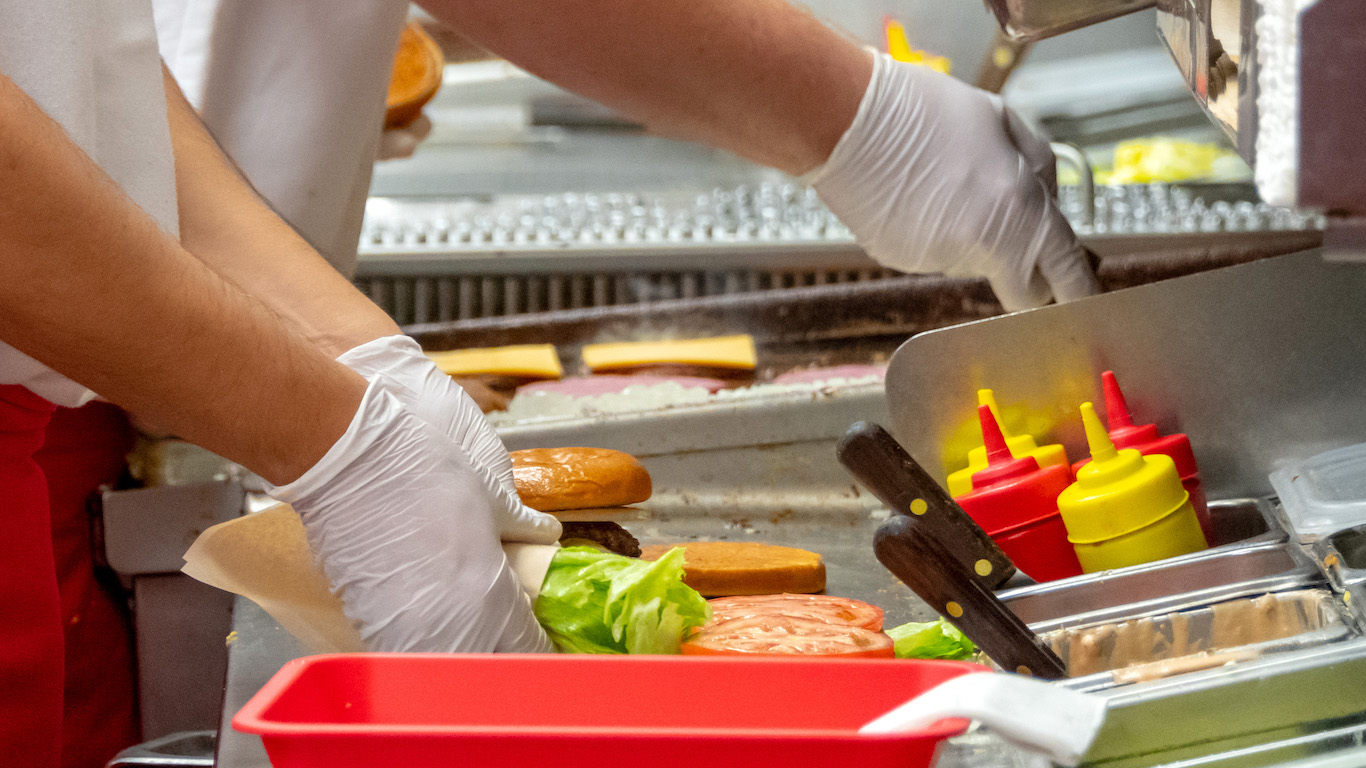Almost 40% of Americans patronize a fast food restaurant at least once a day, according to the Centers for Disease Control and Prevention. Maybe some people actually frequent these chains in search of a healthy meal, but research shows that most people choose such places because they’re cheap and convenient (“fast,” in a word), and because they just happen to like eating burgers and fried chicken and tacos and the rest of the items that fast food establishments offer.
Fast food menus have evolved in recent years, however. Spurred by competition from small but growing “healthy grab-and-go” chains like Sweetgreen, Dig Inn, By Chloe, and Salad and Go, major players like McDonald’s, Taco Bell, and Dunkin’ Donuts are adapting.
Sometimes, new initiatives at these chains are focused on sustainability and the phasing out of artificial ingredients. Taco Bell, for instance, has pledged to start using cage-free eggs, while McDonald’s has started sourcing chicken raised without antibiotics. And just about all the major fast food chains have added, and are promoting, menu items lower in calories, fat, sodium, and sugar than their typical fare.
From Popeyes’ blackened chicken tenders, made with no breading or batter, to Tim Horton’s modestly proportioned Wrap Snackers, to the fresh salads offered by almost everybody these days, it is now possible to find at least some healthy alternatives at almost every fast food outlet.
Nonetheless, a survey conducted in 2017 by brand advisory firm Deloitte found that 83% of Americans surveyed believed that traditional fast food menus (as opposed to those at the grab-and-go chains) did not offer enough healthy choices. If the companies behind the country’s most popular fast food restaurants would respond to market demand, this situation may well change.
In the meantime, it’s possible to find at least a few healthy items at virtually every fast food restaurant. Is it likely that the average customer will go to one of these and order only the low-cal, low-fat options? Probably not, but at least they’re there — apple slices instead of fries with that burger, grits instead of mac ‘n cheese with that fried chicken — to help make the overall experience a little less deleterious.
Methodology
To identify the healthiest option at every major fast food chain in the United States, 24/7 Wall St. reviewed the nutritional contents of every item on their menus. To compare each item, we created an index of calories, fat, salt, and sugar. Foods with relatively few calories, sodium, sugar, and fat compared to other items offered by the same restaurant received higher scores. Only food items intended for single individual consumption were considered. Sides, garnishes, and kids’ items were excluded (unless, in the latter case, they can be ordered individually by adults wishing smaller portions).

Starbucks: Classic Oatmeal
> Serving size: 42 g (1 bowl)
> Calories: 160
> Total amount of sugar: 0.0 g
> Total amount of fat: 2.5 g
> Total amount sodium: 125 mg
Oats are considered one of the healthiest of all grains as they are full of nutrients. They are gluten-free, and, as a good source of fiber, are believed to help control blood sugar and reduce LDL (“bad”) cholesterol. This Starbucks breakfast option is made with whole-grain rolled and steel-cut oats as well as oat flour. It’s served without sweetener, but be aware that adding sugar or honey will also add calories.

McDonald’s: Chicken McNuggets
> Serving size: about 64 g (4 nuggets; individual size varies)
> Calories: 186
> Total amount of sugar: 0.0 g
> Total amount of fat: 11.6 g
> Total amount sodium: 404 mg
In 2016, McDonald’s announced that artificial preservatives would be removed from McNuggets, the chain’s deep-fried boneless chicken white meat pieces. Though more than half their calories come from fat, a four-piece serving is still relatively virtuous simply because it isn’t very big. Be careful with the dipping sauces, though, as they can add calories, sodium, and fat (the Creamy Ranch Sauce is the most caloric, at 110 calories per serving).

Wendy’s: Plain Baked Potato
> Serving size: 9.5 to 12 oz (1 potato; serving size varies)
> Calories: 270
> Total amount of sugar: 3.0 g
> Total amount of fat: 0.0 g
> Total amount sodium: 25 mg
The third largest burger operation by total U.S. sales, Wendy’s is the only major chain offering baked potatoes at all of its American locations. The company sells a million of them a week â 52 million a year â according to Thrillist. Wendy’s serves its spuds with nothing added (potatoes naturally contain small amounts of sodium and sugar), but adding such condiments as cheese, bacon bits, butter, sour cream, and/or salt makes them somewhat less healthy.

Taco Bell: Seasoned Rice
> Serving size: 73.7 g (1 bowl)
> Calories: 120
> Total amount of sugar: 0.0 g
> Total amount of fat: 2.0 g
> Total amount sodium: 190 mg
Enriched long-grain rice accented with tomatoes, bell peppers, various spices, and other ingredients, Taco Bell’s Seasoned Rice is a good choice for the diet-conscious. The chain
suggests numerous possible upgrades, add-ons, and sauces, including guacamole, nacho cheese sauce, beans, seasoned fries, shredded chicken, and creamy jalapeño sauce that can add 30, 80, and even 110 calories per serving.
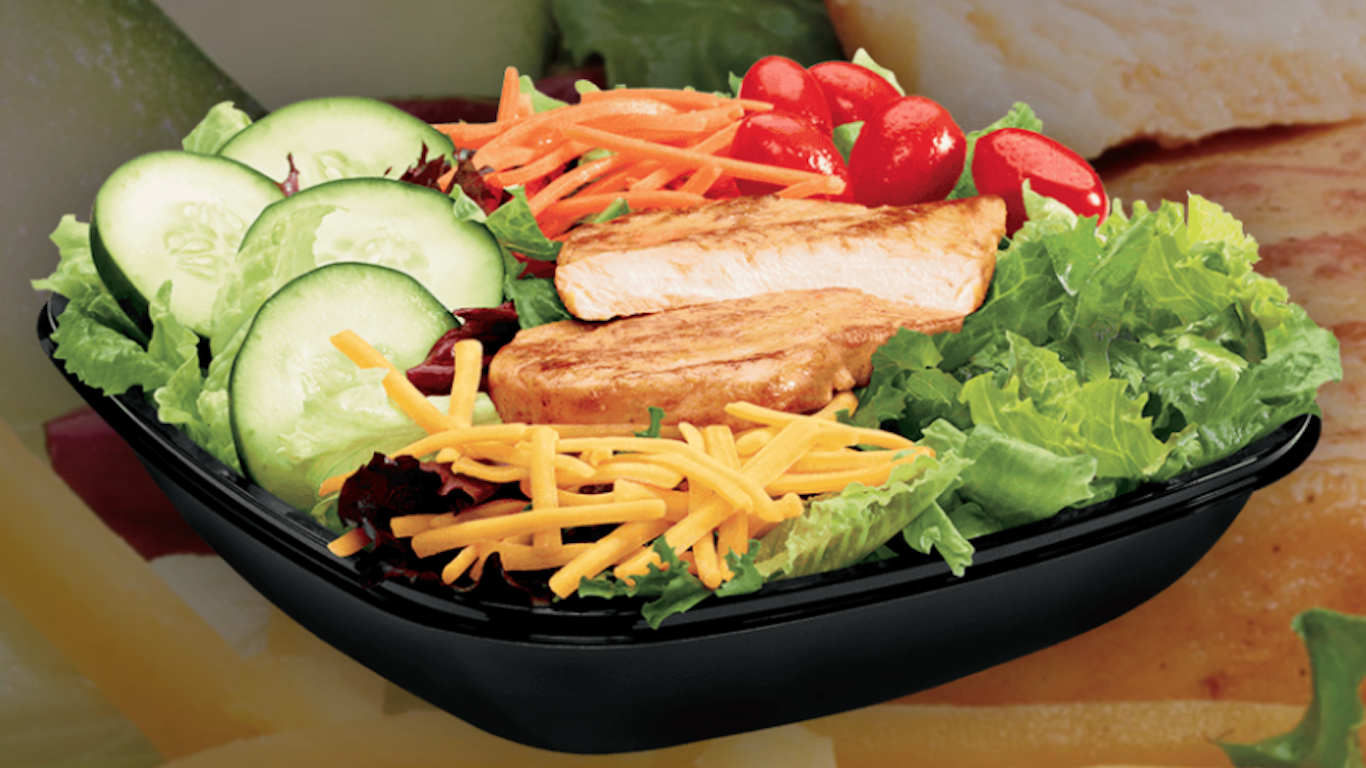
Jack in the Box: Grilled Chicken Salad
> Serving size: 373 g
> Calories: 250
> Total amount of sugar: 13.0 g
> Total amount of fat: 9.0 g
> Total amount sodium: 750 mg
This salad is a smaller version of the chain’s main course chicken salad. It is made with white meat of chicken, lettuce, grape tomatoes, cucumbers, carrots, and shredded cheddar cheese. The nutritional values here don’t include dressing (Jack in the Box’s creamy Southwest dressing has 190 calories for a 1.8 oz. serving), unfortunately, nor do they include the corn sticks that are a standard accompaniment (another 60 calories per stick).
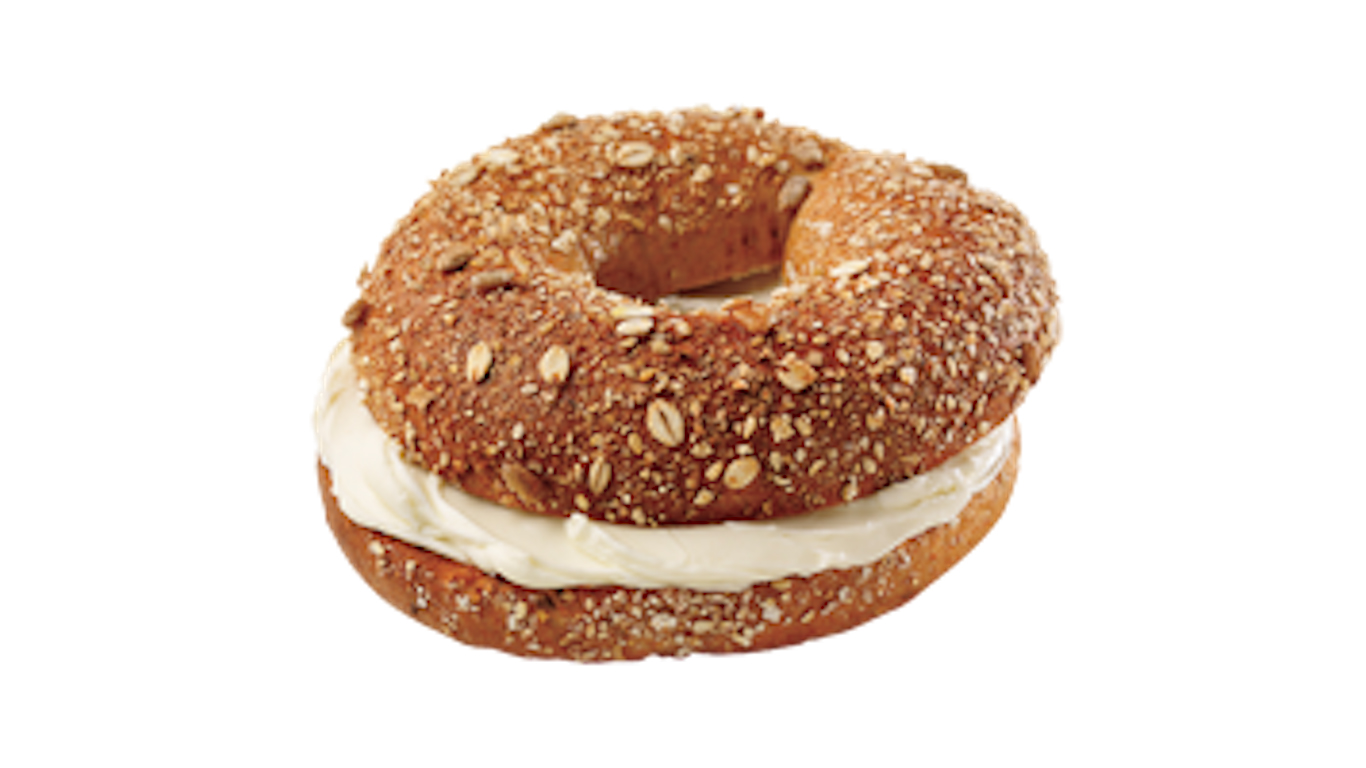
Dunkin’ Donuts: Multigrain Bagel
> Serving size: 113 g (1 bagel)
> Calories: 380
> Total amount of sugar: 8.0 g
> Total amount of fat: 8.0 g
> Total amount sodium: 550 mg
This bagel is one of Dunkin’s DDSMART menu choices, items that, according to the company, “are reduced in calories, fat, saturated fat, sugar or sodium by at least 25% compared to a base product or other appropriate reference product and/or contain an ingredient or nutrient that is nutritionally beneficial.” Though the bagel contains almost a quarter of the recommended daily intake of sodium, it is low in saturated fat and high in fiber. Needless to say, a slathering of cream cheese will noticeably increase the fat and calorie count.

Panera Bread: Steel Cut Oatmeal with Almonds, Quinoa & Honey
> Serving size: 1 bowl
> Calories: 320
> Total amount of sugar: 7.0 g
> Total amount of fat: 8.0 g
> Total amount sodium: 200 mg
This popular soup and sandwich chain devotes a page on its website to “Why We Loveâ¦Apples,” and the lowest-calorie, healthiest option the chain offers is just that â an apple, with nothing added. For something a little more substantial, the best choice might well be this combination of steel-cut oats, oat groats (the hulled kernels of the grain), and organic red and golden quinoa, sweetened with honey and topped with toasted almonds and cinnamon.
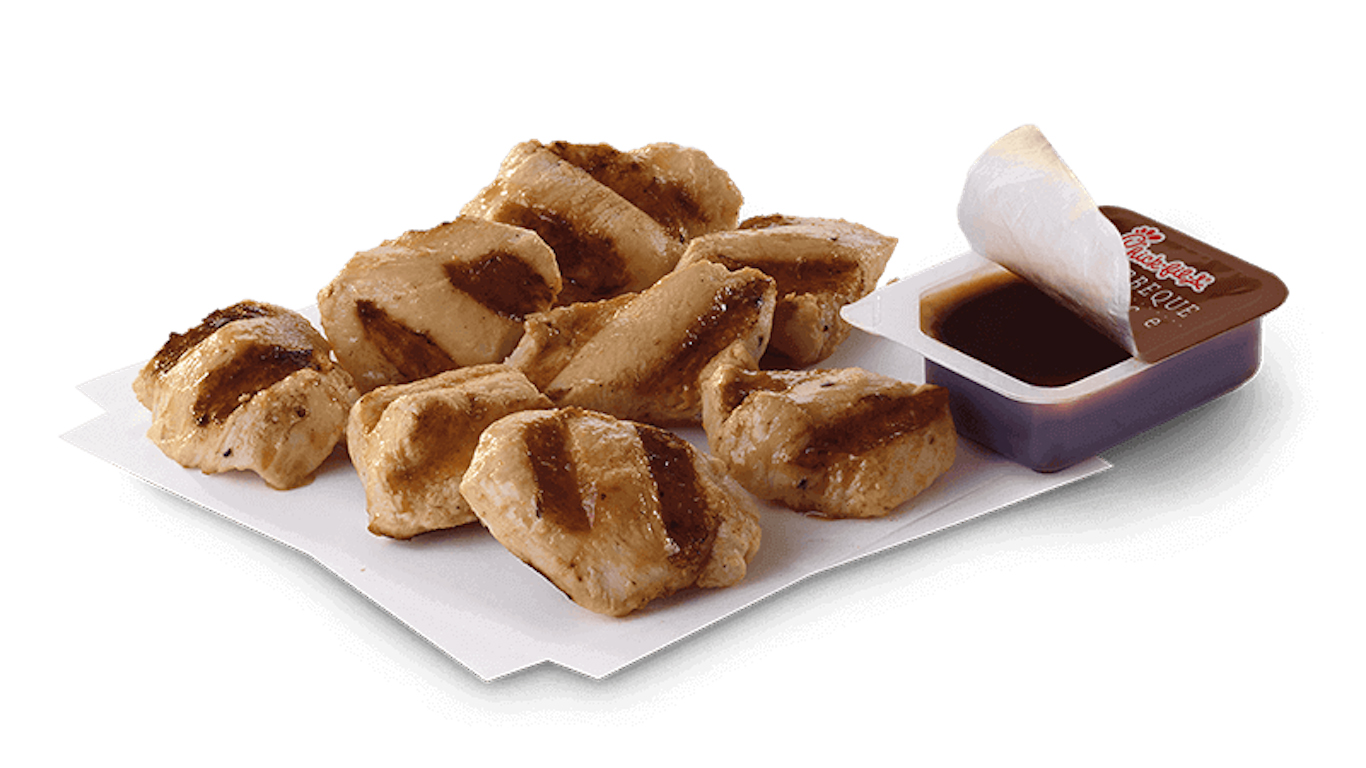
Chick-Fil-A: Grilled Chicken Nuggets
> Serving size: 113 g (8 nuggets)
> Calories: 140
> Total amount of sugar: 0.0 g
> Total amount of fat: 3.5 g
> Total amount sodium: 440 mg
These are not the usual heavily breaded nuggets â they’re irregularly shaped, unbreaded pieces of boneless chicken breast, marinated and grilled on cast-iron grates. As always with nuggets and tenders, the danger is in the accompanying dipping sauces. In Chick-Fil-A’s case, the choices range from 25 to 140 calories per 1-oz. portion, with Zesty Buffalo on the low end and Garlic & Herb Ranch and Chick-Fil-A Sauce at the top.
White Castle: The Original Slider
> Serving size: 55 g (1 slider)
> Calories: 140
> Total amount of sugar: 2.0 g
> Total amount of fat: 7.0 g
> Total amount sodium: 380 mg
This iconic, widely imitated mini-burger â a small, square patty on a small, spongy, dome-topped bun â is relatively healthy due to its modest size. Note that, for whatever reasons, the slider is slightly bigger and has a few more calories in New Jersey and New York, coming in at 60 g and 150 calories in those states.
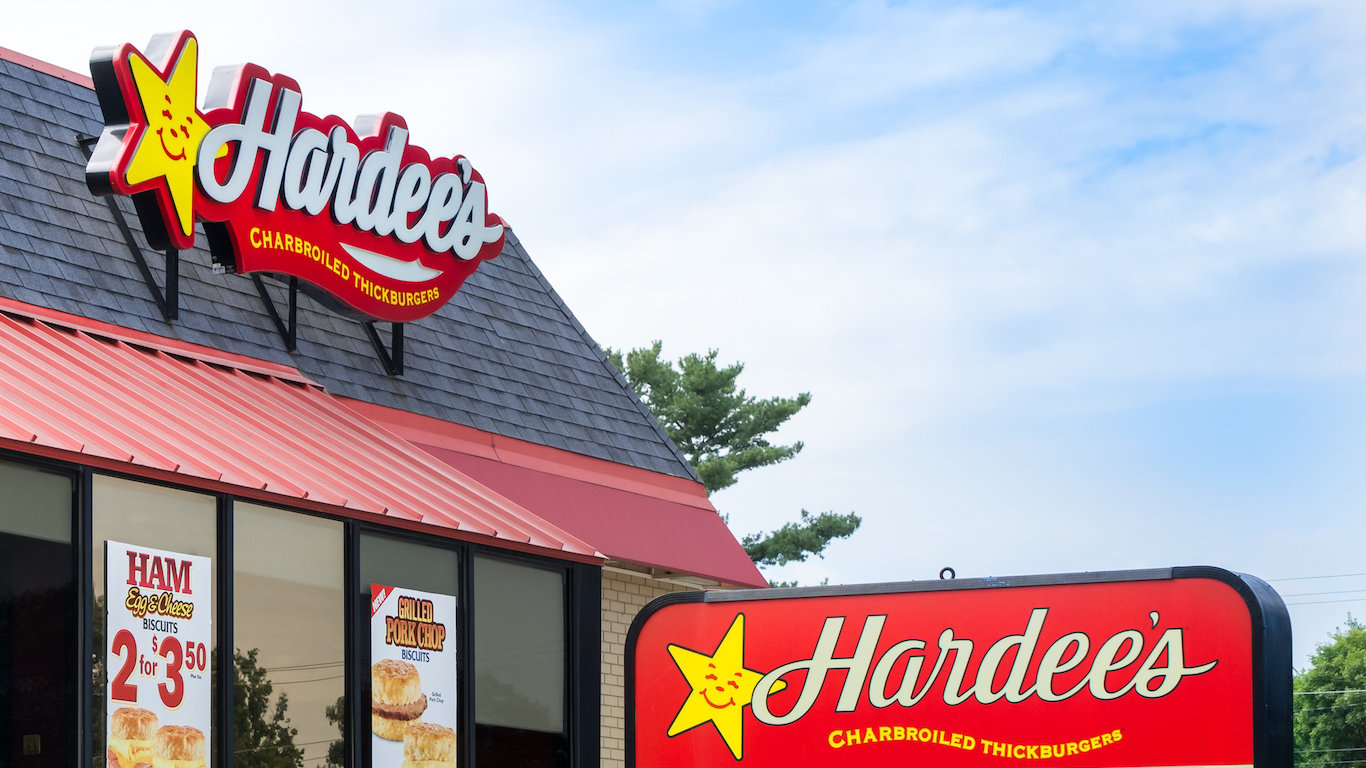
Hardee’s: Grits
> Serving size: 142 g (1 bowl)
> Calories: 110
> Total amount of sugar: 0.0 g
> Total amount of fat: 4.5 g
> Total amount sodium: 260 mg
Hardee’s is basically the same fast-food chain as Carl’s Jr.. Both are under the same ownership, but the states in which Hardee’s operates include the entire South (except Texas) â a region where grits tend to be a popular breakfast food. Grits are a good choice for a morning side dish as they are notably lower in calories, sodium, fat, and sugar than the chain’s other option, its trademark “Hash Rounds.”

Subway: Veggie Delite Sandwich
> Serving size: 163 g (1 6-inch sandwich)
> Calories: 200
> Total amount of sugar: 5.0 g
> Total amount of fat: 2.0 g
> Total amount sodium: 280 mg
This six-inch sub on nine-grain wheat bread combines lettuce, spinach, tomatoes, onions, green peppers, and cucumbers, dressed with a serving of “Fresh Fit” sauce.
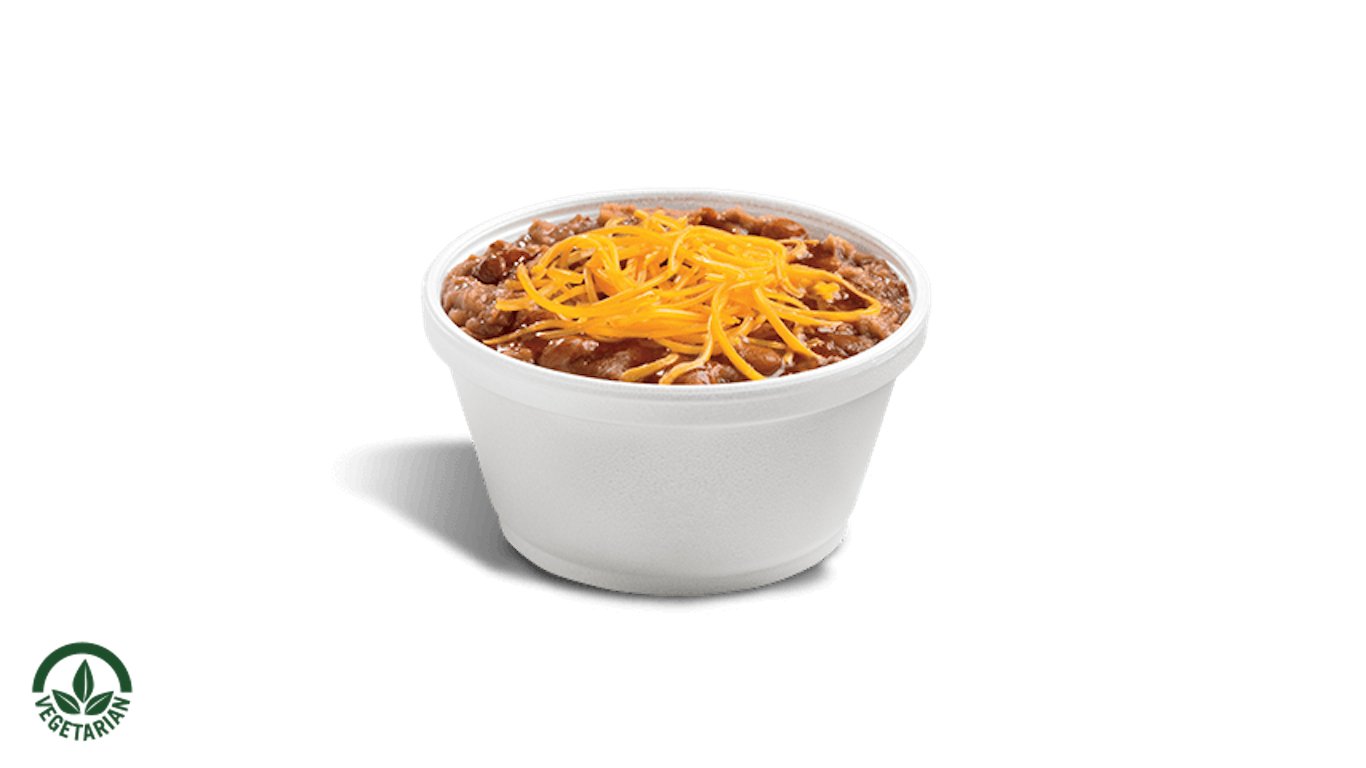
Del Taco: Bean & Cheese Cup
> Serving size: 220 g (1 cup)
> Calories: 320
> Total amount of sugar: 1.0 g
> Total amount of fat: 3.5 g
> Total amount sodium: 830 mg
This California-born chain, now headquartered in the Chicago area, is the nation’s third-largest Mexican fast-food group, after Taco Bell and Chipotle. There are two versions of the bean recipe, depending on regional suppliers.

Sonic: Fries Small
> Serving size: 71 grams (1 bag)
> Calories: 250
> Total amount of sugar: 0.0 g
> Total amount of fat: 12.0 g
> Total amount sodium: 260 mg
Fries are never a healthy choice, but the Sonic menu offers fewer healthy choices than those of some of its competitors. A small portion of Sonic fries is at least relatively restrained in calories, fat, and sodium. The chain uses russet potatoes for its fries, leaving some skin on for what it calls a “natural cut” â designed to produce crisper results.

Tim Horton’s: Chicken Ranch Wrap Snacker
> Serving size: 123 g (1 wrap)
> Calories: 190
> Total amount of sugar: 1.0 g
> Total amount of fat: 6.0 g
> Total amount sodium: 620 mg
These smaller-sized wraps were off the Tim Horton’s menu for a time, but reappeared last spring. They’re made with strips of white meat chicken, lettuce, tomatoes, and ranch dressing on a whole wheat tortilla.

Whataburger: Apple Slices
> Serving size: 57 g (1 bag)
> Calories: 30
> Total amount of sugar: 0.0 g
> Total amount of fat: 0.0 g
> Total amount sodium: 0 mg
This 69-year-old Texas-based chain offers a little bag of apple slices as a healthier alternative to fries. However, it also notes that the slices go well with shakes, cookies, or onion rings, which might make customers wonder why they didn’t just get the fries in the first place.
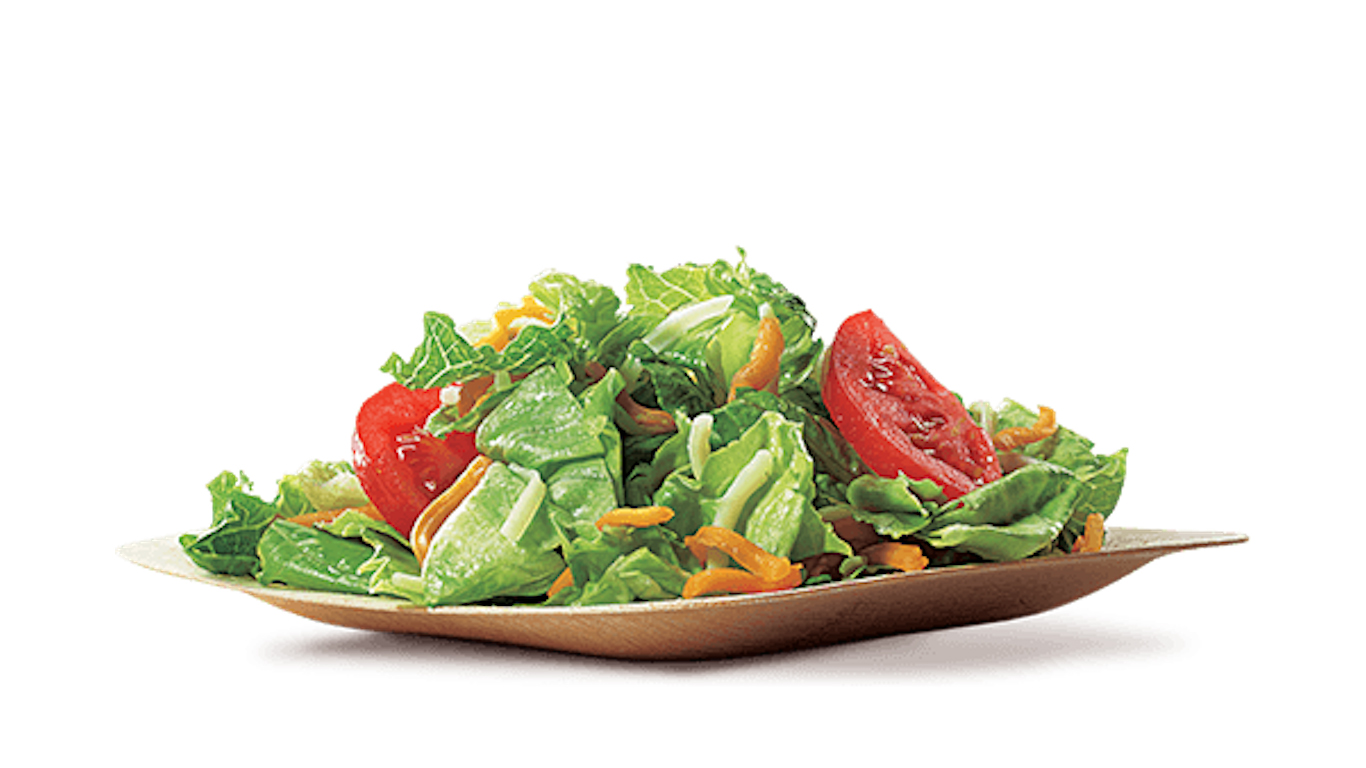
Burger King: Garden Side Salad – w/o dressing or croutons
> Serving size: 99 g
> Calories: 60
> Total amount of sugar: 2.0 g
> Total amount of fat: 4.0 g
> Total amount sodium: 95 mg
As the second largest burger chain in America after McDonald’s, Burger King is of course best-known for its burgers, but an obviously much less caloric choice would be this salad of assorted lettuces with tomatoes and a mix of three cheeses. Be wary, though: the “buttery garlic” croutons that come in a separate packet double the calorie count â and a packet of dressing will add anywhere between 120 to 260 calories to the salad. If you want to eat 240 calories (salad, croutons, and Lite Honey Balsamic Vinaigrette), you could order a regular burger instead.

Carl’s Jr.: Kid’s Hand-Breaded Chicken Tenders
> Serving size: 85 g (2 tenders)
> Calories: 180
> Total amount of sugar: 0.0 g
> Total amount of fat: 9.0 g
> Total amount sodium: 520 mg
Carl’s Jr. is under the same corporate ownership as Hardee’s (see above). Carl’s Jr. covers the western half of the country, Hardee’s the eastern, and they chains have an almost identical menu. Unlike Hardee’s, however, Carl’s Jr. doesn’t serve grits. Its healthiest menu option, then, is this duo of buttermilk-dipped, lightly breaded chicken tenders. A small tub of buttermilk ranch dipping sauce will add another 100 calories.

Bojangles: Green Beans
> Serving size: 90 g (1 cup)
> Calories: 40
> Total amount of sugar: 1.0 g
> Total amount of fat: 0.0 g
> Total amount sodium: 740 mg
Bojangles touts its “Famous Chicken ‘n Biscuits,” but also offers a number of side dishes, including cole slaw, Cajun pinto beans, grits, mac ‘n cheese â and green beans, cooked with bits of tomato and assorted seasonings.
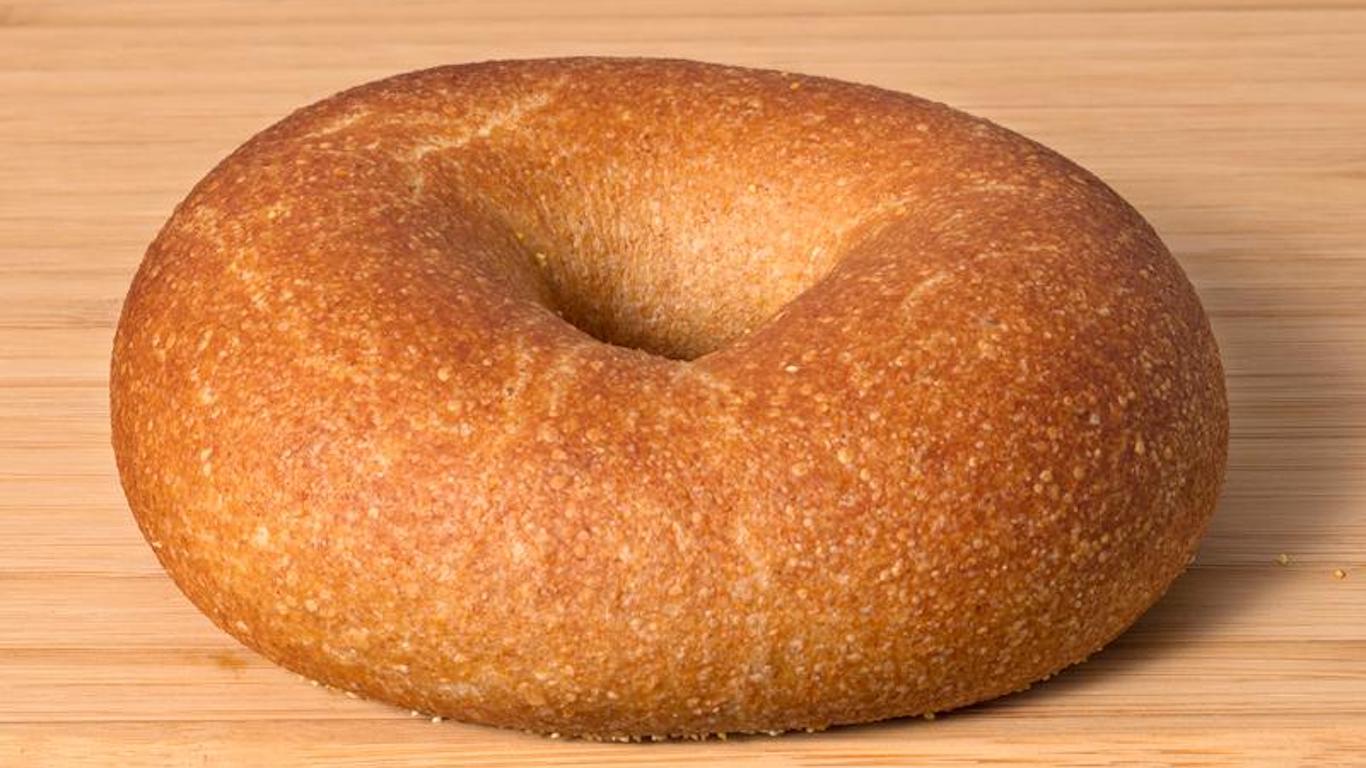
Einstein Bros Bagels: Honey Whole Wheat
> Serving size: 102 g (1 bagel)
> Calories: 260
> Total amount of sugar: 7.0 g
> Total amount of fat: 3.0 g
> Total amount sodium: 550 mg
Like other Einstein varieties, this is slightly smaller than some other chain bagels. It’s made with whole wheat flour sweetened with honey and brown sugar. As with any bagel, adding cream cheese adds calories â 110 to 120 per serving in the case of Einstein’s Whipped Reduced Fat Cream Cheese Schmears.

Krystal: Side Grits Bowl
> Serving size: 257 g (1 bowl)
> Calories: 210
> Total amount of sugar: 0.0 g
> Total amount of fat: 5.0 g
> Total amount sodium: 520 mg
Established in Chattanooga, Tennessee, in 1932 and now comprising some 350 locations in 11 Southern states, Krystal serves burgers, hot dogs (or “pups”), and chicken sandwiches and wings, among other items. Its sides include Kryspers (fried hash brown strips), three variations of fries, chili, and â this being a Southern chain â grits, moistened with butter.

KFC: Whole Kernel Corn
> Serving size: 95 g (1 bowl)
> Calories: 100
> Total amount of sugar: 2.0 g
> Total amount of fat: 0.5 g
> Total amount sodium: 0 mg
Potatoes aside, the KFC menu isn’t big on vegetables, but in addition to cole slaw and green beans, it does offer this surprisingly low-calorie (and unsalted) serving of sweet yellow corn kernels, cut from the cob.

Popeyes: Handcrafted Tenders – Blackened
> Serving size: 113 g (3 tenders)
> Calories: 170
> Total amount of sugar: 0.0 g
> Total amount of fat: 2.0 g
> Total amount sodium: 550 mg
Unlike other chicken specialties at this popular fried chicken chain â the third largest by U.S. sales â the blackened tenders have no breading or batter. These tenders (three to an order) account for about a quarter of the daily sodium intake recommended by the Food and Drug Administration â which sounds like a lot, until you realize that three of the regular tenders contain more than three times the sodium of the blackened ones (also more than two-and-a-half times the calories).

Arby’s: Chopped Side Salad
> Serving size: 128 g
> Calories: 70
> Total amount of sugar: 2.0 g
> Total amount of fat: 5.0 g
> Total amount sodium: 100 mg
“We love you, lettuce. You’re almost like a meat to us,” proclaims this meat-centric chain’s website. This side salad is made with lettuce (not too finely chopped, as it happens) with tomato wedges and shredded cheddar.

Dairy Queen: Side Salad
> Serving size: 113 g
> Calories: 25
> Total amount of sugar: 3.0 g
> Total amount of fat: 0.0 g
> Total amount sodium: 15 mg
Lettuce, tomatoes, carrots, and red cabbage comprise this low-calorie salad. The chain offers 11 different Marzetti brand dressings for the salad, ranging in calories from 15 per portion for Light Italian to 210 for Thousand Island (but the bad news is that the Light Italian has the highest sodium count of any of them, with 730 milligrams.)

Baskin-Robbins: Lemon Sorbet
> Serving size: 71 g (1 small scoop)
> Calories: 60
> Total amount of sugar: 11.0 g
> Total amount of fat: 0.0 g
> Total amount sodium: 0 mg
This venerable ice cream chain is famous for its uncommon flavors â Bourbon Street Pecan Pie, Cotton Candy, Pink Bubblegum, Creole Cream Cheese, and the like â but a small (kid-size) scoop of fancy flavors like those can have as much as 280 calories. Lemon sorbet is a fraction of that, with no fat or sodium added. (Baskin-Robbins regularly alternates flavors on its menu, so this option might not always be available.)
